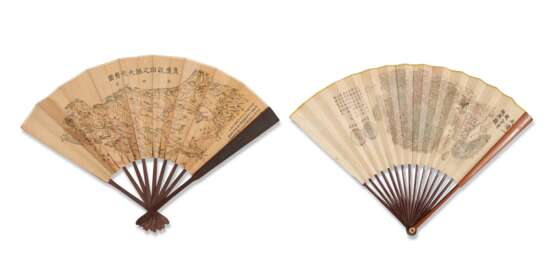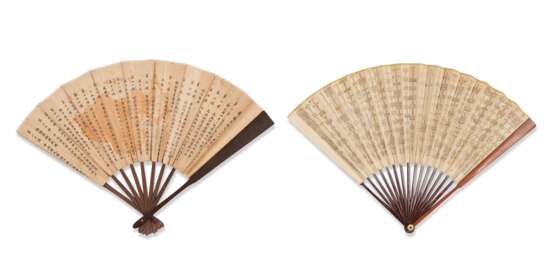ID 627613
Los 124 | Two cartographic fans
Schätzwert
$ 500 – 800
Map of All Unified Provinces of the Qing Empire renders the provinces of late-Qing China in a somewhat distorted perspective, with the southeast province Hainan depicted on the left. The verso of the leaf is listed with prefectures, states and counties under the jurisdiction of each province, including Taiwan, which was upgraded to a provincial administrative unit in 1885, and ceded to Japan in 1895. Therefore, the production of the map should be within this decade. Apart from the Chinese provinces, Japan is seen portrayed on the right side, occupying a pretty large and prominent area, beside which, a compass is delineated with north at the upper right corner. An inscription is printed on the left, below which is a double hemisphere image and on the right side of which is another compass. The style of this map is close to the Complete Map of the Twenty-three Provinces of the Great Qing Dynasty with a Provincial Map of Korea, which was also produced during 1885-1895, in the collection of the Geography and Map Division of the Library of Congress, US. Map Calling on the Urgent Recouping of Lüshun and Dalian shows the plan of Lü-Da District (Lüshun and Dalian), that is, the land to the south of Jinzhou Bay, to the east of Lüshun Port and to the west of Dalian Bay, with depictions of the South Manchuria Railway. The inscription on the right reveals that the map fan served as a propaganda tool supporting Chinese government’s recouping of the Lü-Da District, which was ceded to Russia in 1895, then from Russia to Japan in 1904. In 1915, the agreed year of the return of the district to China, Japan proposed the Twenty-One Demands, a demand of which requesting the extension of the leasehold over the Lü-Da District for 99 years. The Demands were abolished in 1923. Thus this fan, which criticizes the Japanese demands and urged the recoup of the territory, should be dated to 1915-1923. The verso of the leaf details the content of the Demands with a line of signature stating “a member of the Republic of China transcribing this for his countryman,” on a ground with pale orange map of China. The design of the map fan was widely circulated during 1915-1923; different versions of the map were printed by different patriotic social organizations and individuals. Reference: Kuo-Hsin Hsieh & Ralph E. Ehrenberg, Reading Imperial Cartography: Ming-Qing Historical Maps in the Library of Congress (2013), pp. 83.
Two chromolithographic maps, the verso with calligraphy, ink and colors printed on paper, with bamboo sticks; stored in two separate blue paper case without lid. Map of All Unified Provinces of the Great Qing: printed on mica-flecked paper, chartreuse border on the upper edge, lacquered bamboo sticks and plain bamboo guard sticks (the outer surface left unlacquered) with rounded heads, where a bamboo rivet passes through, washer of white stone, approx. 310 x 450mm unfold. Map Calling on the Urgent Recouping of Lü-Da District: title to the top, beige paper border on the upper edge, the guard sticks carved with the props of the Eight Immortals, four on each side, approx. 320 x 450 mm unfolded; cannons and some annotations printed in red. (Map of All Unified Provinces of the Great Qing: the bamboo monture well-polished, lacquer at the area around the washers slightly peeling off, light pink and blue stains on the front side of leaf, some tears along the lower margin of the leaf, guard sticks slightly curved. Overall very good condition. Map Calling on the Urgent Recouping of Lüshun and Dalian: the rivet and the second-to-left bamboo stick lost, the third-to-right bamboo stick broken from the head to the hole for rivet, tears on paper along the upper and lower margin, stains on the back at the upper right section, bamboo guard sticks curved.)
Please note that this lot is subject to an import tariff. If the buyer instructs Christie’s to arrange shipping of the lot to a foreign address, the buyer will not be required to pay the import tariff. If the buyer instructs Christie’s to arrange shipping of the lot to a domestic address, if the buyer collects the property in person, or if the buyer arranges their own shipping (whether domestically or internationally), the buyer will be required to pay the import tariff. Please contact Post Sale Services on +1 212 636 2650 prior to bidding for more information.
| Künstler: | William Shakespeare (1564 - 1616) |
|---|---|
| Angewandte Technik: | Bleistift |
| Künstler: | William Shakespeare (1564 - 1616) |
|---|---|
| Angewandte Technik: | Bleistift |
| Adresse der Versteigerung |
CHRISTIE'S 8 King Street, St. James's SW1Y 6QT London Vereinigtes Königreich | |
|---|---|---|
| Vorschau |
| |
| Telefon | +44 (0)20 7839 9060 | |
| Aufgeld | see on Website | |
| Nutzungsbedingungen | Nutzungsbedingungen |













